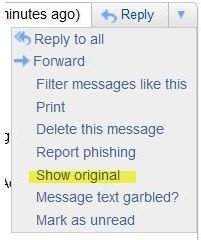How to Show the IP Address in Gmail and the Gmail Header
Since the early days of Gmail it has emerged into a leading provider of web-based email, not only for individuals but also for schools and businesses. What’s more is that Google has integrated chat into Gmail, known as GTalk, and additionally extended the email solution with a search function, and effective Spam filter and a conversation view. Among the other advantages it has are a priority inbox, Gmail on the go (Email Access from your phone), HTTPS encryption, and the ability to call phones from within Gmail - U.S. and Canada for free.
For your convenience Google hides the Gmail header and IP Address in Gmail, but sometimes you may want to know the sender’s IP which is part of the email header. Read on here to learn how to find the sender information in Google mail:
Displaying The Header
An email message is made up of three components: a message envelope, a message header, and a message body. Sometimes one is interested in the originating IP address of a digital message and other pertinent header information, but Google does not display it by default. To view an email header in Gmail you have to open a particular message. On the right side at the top of the message, right beside the reply arrow button, select the drop down arrow key.
Select Show original. The message will open in a new window.

The Gmail header needs to be read bottom-up:
In the To: field - above Date: - you will find the recipient(s) (including your) email address(es). It may or may not include the name(s) of the recipient(s).
Above the To: field will see a From: field. This is the sender’s email address.
Above the From: field there will be one or more Received: from – fields. Inspect the last near the end of header. The four octets in square brackets are the IP address of the sender, loosely speaking the IP Address in Gmail**.**
Example:
Received: from zdmta.response.enterprise-alerts.com (zdmta.response.enterprise-alerts.com [128.177.32.50])
This message was sent from the host zdmta.response.enterprise-alerts.com with the IP address of 128.177.32.50.
When the IP Address is Hidden
Google does not show the IP Address in Gmail if the sender used Web-based Gmail or Google mail for sending the message. The originating IP address is only revealed in the Gmail header if the sender has been using a regular mail server and mail client, such as Microsoft Exchange Server and Outlook as client email program. There’s no precise information available why Google restricts viewing the IP Address in Gmail if the message was sent using Gmail, but it’s probably safe to assume they hide the Gmail header property for privacy reasons.
Other Useful Header Information
The Gmail header additionally includes a Date: field. This is the local time and date when the message was sent to the recipient(s).
Usually you also find the following pieces of information in a message sent to your Gmail account:
The Subject: field contains the topic of the message and might include common abbreviations for Reply and Forward “RE:” and “FW:”.
In the CC: field you see the recipients of the email who have been addressed by means of carbon copy.
The Received: field then gives you tracking information of the servers that handled the email message until it was finally delivered into your inbox. The display order is reversed!
Finally, in the Return-Path: field you see the recipient email address if you hit the Reply-button.
Using the Header information to fight Spam
Gmail header information, mainly the sender’s IP address (IP Address in Gmail) can be used to track down spammers and to stop other mischief arriving in your inbox. You can, for instance, demand to be removed from a mailing list according to the CAN-Spam Act, or complain with the sender’s ISP or domain registrar which you find by running a lookup with the sender’s IP address such as with https://ip-lookup.net’s Lookup an IP Address function. If that’s too much effort simply hit the Spam button in Gmail to redirect future unsolicited messages from the same sender to the Spam folder.
Should you on the other hand believe a message is a phishing attack, then please click the drop down arrow key on the right side to report it to Google by means of the report phishing menu entry – you may save someone from becoming a victim of online fraud and do the world a favor!
References
- Author’s own opinion
- Screenshots by the writer
